 |
Langley Research CenterTurbulence Modeling Resource |
Jump to: SA Results, SA-QCR2000 Results, SSTm Results, SSG/LRR-RSM-w2012 Results, K-kL-MEAH2015 Results
Return to: Fully-Developed Channel Flow Validation Intro Page
Return to: Turbulence Modeling Resource Home Page
2D Fully-Developed Channel Flow at High Reynolds Number Validation Case
Wilcox2006-klim-m Model Results
Link to Wilcox2006-klim-m equations
Previously on this page the results were reported as Wilcox2006-klim solutions, but more properly they should be referred
to as Wilcox2006-klim-m. Essentially no difference is expected.
Above Wilcox2006-klim-m results are from CFL3D on the finest 161x513 grid.
CFL3D used freestream turbulence intensity=0.039% and freestream turbulent viscosity (relative to laminar)=0.009
(additional details can be found in the CFL3D User's Manual, Appendix H).
Please read note 5 on Notes on running CFD page.
Note that these are compressible code results; results will be somewhat different for incompressible codes.
In fact, for incompressible flow, the Cf and v*/Uref should become constant (moving downstream) rather
than slowly linearly increasing as shown here.
Note that the quantity v* (as defined in
White, F. M., Viscous Fluid Flow, McGraw-Hill, New York, 1974, pp. 471-474) is often referred to as u_tau.
Note also that Uref used in the above plots is not bulk velocity, but rather
the velocity at the reference position upstream where M=0.2.
The density (used to compute Cf) is also referenced there.
Results are assumed to be sufficiently "fully developed" by
x=500. Looking at the "Karman Measure" (KM), the value of
"kappa" produced by this turbulence model is close to 0.400 over much of the log layer.
Because Wilcox2006-klim-m is a linear (Boussinesq) model, there is essentially no separation between u'u', v'v', and w'w'.
Note that this model is currently assigned
MRR Level 2 for the purposes of this website.
This is because at this time the TMBWG has results for this model
from two different codes from the same home organization.
The results on this page are therefore not necessarily
reliable until additional independent code(s) can be used to verify the model implementation.
CFL3D results are given here:
w06_cf_vs_x_cfl3d.dat,
w06_utau_vs_x_cfl3d.dat,
w06_u_cfl3d.dat,
w06_u+y+KM_cfl3d.dat,
w06_mut_cfl3d.dat,
w06_plus_cfl3d.dat.
A typical CFL3D input file is:
w06_cfl3d_typical.inp.
Jump to: SA Results,
SA-QCR2000 Results,
SSTm Results,
SSG/LRR-RSM-w2012 Results,
K-kL-MEAH2015 Results Return to: Fully-Developed Channel Flow Validation Intro Page Return to: Turbulence Modeling Resource Home Page
Recent significant updates: Responsible NASA Official:
Ethan Vogel
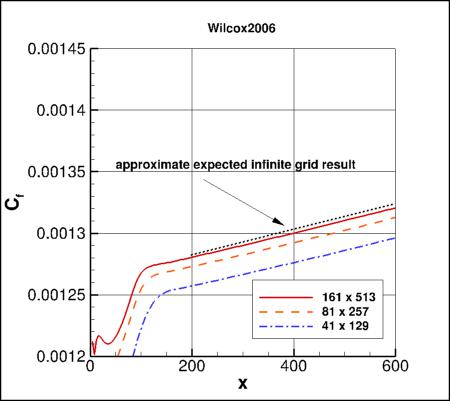
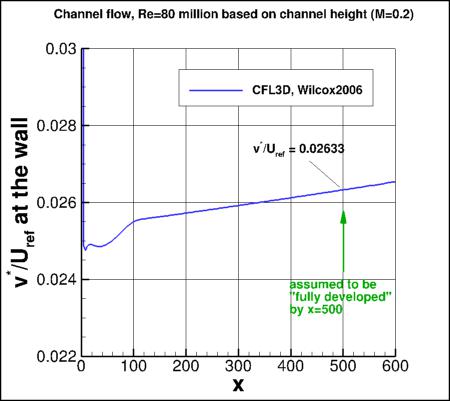

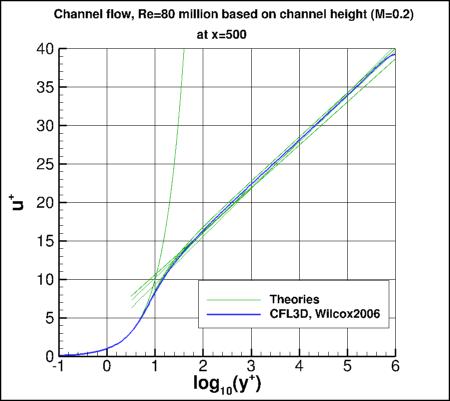


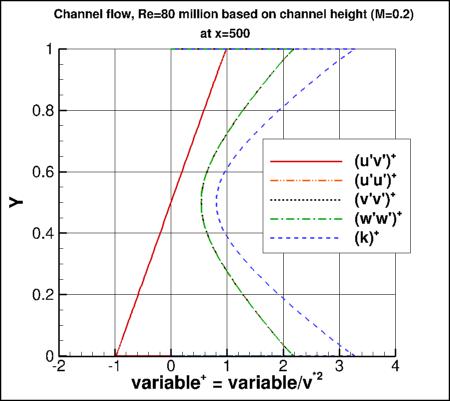
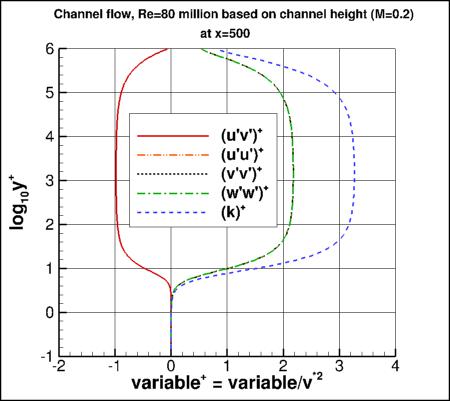
02/01/2022 - added mention of expected results for incompressible flow
Page Curator:
Clark Pederson
Last Updated: 02/01/2022